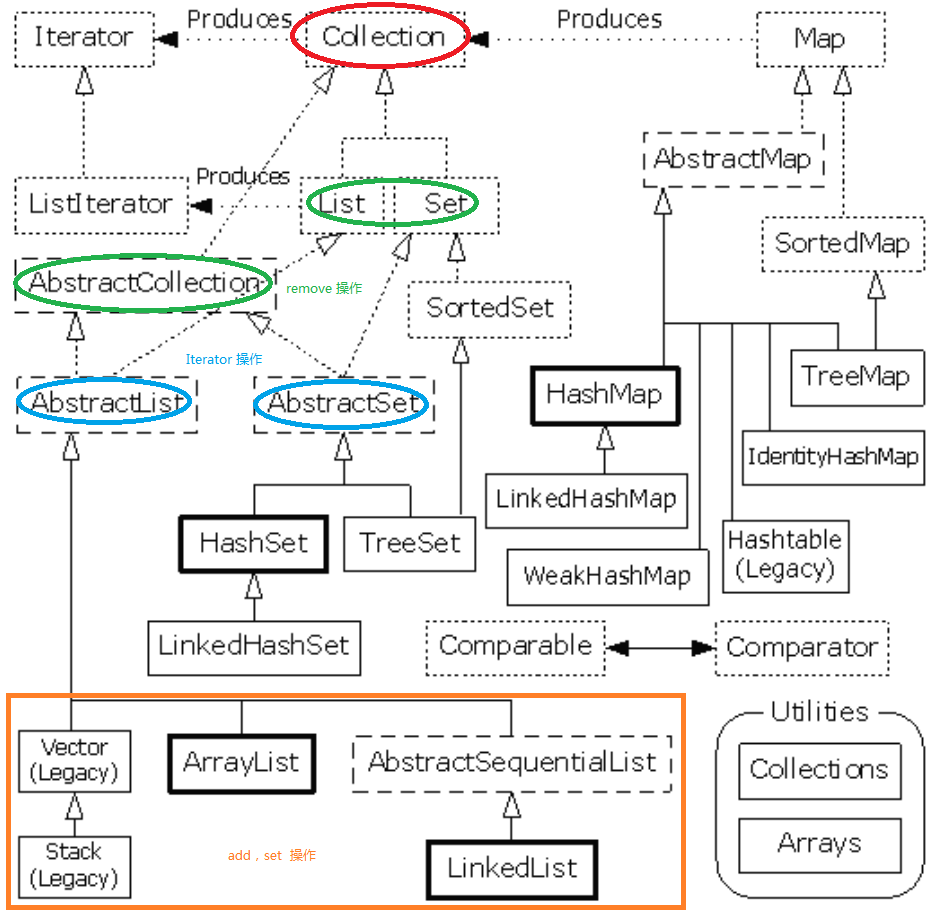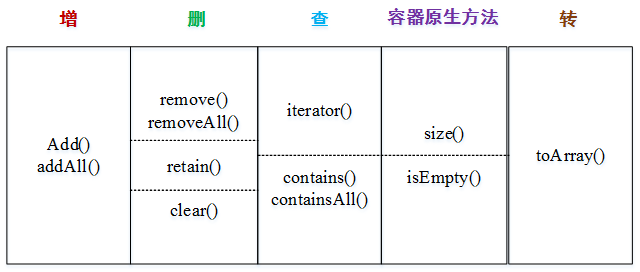Java Collection Framework : Collection 接口
来源:互联网 发布:天音淘宝宝贝裂变工具 编辑:程序博客网 时间:2024/04/29 07:21
一、要点
- Collection 接口
- Collection 接口的默认实现:AbstractCollection
- Optional operations(可选方法)
二、Collection 接口
1、JDK 对 Collection 接口的描述
Collection 接口是 Collection 层次结构中的根接口。Collection 表示一组对象,这些对象也称为 collection 的元素。一些 collection(List,Queue) 允许有重复的元素,而另一些(Set)则不允许。一些 collection (List,Queue)是有序的,而另一些(Set)则是无序的。JDK 不提供此接口的任何直接实现:它提供更具体的子接口(如 Set 和 List)实现,这些子接口继承自Collection 接口。此接口通常用来传递 collection(多态),并在需要最大普遍性的地方操作这些 collection。
所有通用的 Collection 实现类(通常通过它的一个子接口间接实现 Collection)应该提供 两个“标准”构造方法: 一个是 void(无参数)构造方法,用于创建空 collection;另一个是带有 Collection 类型单参数的构造方法,用于创建一个具有与其参数相同元素新的 collection。实际上,后者允许用户复制任何 collection,以生成所需实现类型的一个等效 collection。尽管无法强制执行此约定(因为接口不能包含构造方法),但是 Java 平台库中所有通用的 Collection 实现都遵从它。
此接口中包含的“破坏性”方法,是指可修改其所操作的 collection 的那些方法,如果此 collection 不支持该操作,则指定这些方法抛出 UnsupportedOperationException(可选操作)。
Collections Framework 接口中的很多方法是根据 equals 方法定义的。
Collections Framework 中的各个容器均是非线程安全的。
Collection 接口的定义如下:
public interface Collection<E> extends Iterable<E> { ... } 
2、行为
java.util.Collection 接口是描述 Set 和 List 集合类型的根接口,下面给出了Collection 的所有行为(不包括从Object 继承而来的方法),因此它们也刻画了 Set 或 List 执行的所有行为(List 还有额外的功能)。Collection 的行为分类和详细列表如下 :

表1. Collection 的操作
Collection<? extends T>) 添加参数中的所有元素,只要添加进任意元素则返回 true 可选操作 Iterator iterator( ) 遍历容器中的元素(统一的访问、遍历方法,对外屏蔽了不同容器的差异性,迭代器模式) 依赖于具体实现 boolean remove(Object) 向容器移除指定元素,若移除动作发生,则返回 true(若有重复对象,一次只删除其中一个) 可选操作 boolean removeAll(Collection<?>) 向容器移除参数中所有元素,若有移除动作发生,则返回 true 可选操作 Boolean retainAll(Collection<?>) 只保存参数中的元素,只要Collection 发生改变,则返回 true 可选操作 void clear() 移除容器中所有元素 可选操作 boolean contains(T) 若容器持有该元素,返回 true 依赖于equals() Boolean containsAll(Collection<?>) 若容器持有参数中的所有元素,返回 true 依赖于equals() object[] toArray() 返回一个包含该容器所有元素的 Object 型数组 Array与Collection之间的桥梁,在 AbstractCollection 中提供默认实现,子类可以对它重写 T[] toArray(T[] a) 返回一个包含该容器所有元素的 Object 型数组,且返回结果的运行时类型与参数数组 a 相同,而不单纯是object Array与Collection之间的桥梁,在 AbstractCollection 中提供默认实现,子类可以对它重写 int size() 返回容器中元素数目 依赖于具体实现 boolean isEmpty() 容器为空,则返回 true 依赖于size()注意到,其中不包含随机访问所选择的元素 get() 方法,因为 Collection 包含 Set,而 Set 是自己维护顺序的。因此,若想访问、遍历 Collection 中的元素,则必须使用迭代器; 另外,这些方法的默认实现(AbstractCollection)均直接或间接使用了迭代器。
三、Collection 接口的默认实现:AbstractCollection
1、JDK 对 AbstractCollection 抽象类的描述
此抽象类提供 Collection 接口的骨干实现,以最大限度地减少实现此接口所需的工作。 要实现一个不可修改的 collection,编程人员只需扩展此类,并提供 iterator 和 size 方法的实现。(iterator 方法返回的迭代器必须实现 hasNext 和 next。); 要实现可修改的 collection,编程人员必须另外重写此类的 add 方法(否则,会抛出 UnsupportedOperationException),iterator 方法返回的迭代器还必须另外实现其 remove 方法(AbstractCollection 的移除方法间接调用迭代器的移除方法)。按照 Collection 接口规范中的建议,编程人员通常应提供一个 void (无参数)和 Collection 构造方法。

AbstractCollection 抽象类定义如下:
public abstract class AbstractCollection<E> implements Collection<E> { ... }2、行为(对上述 Collection 接口中方法的实现情况)
下面给出了抽象类 AbstractCollection 对 Collection 接口的实现情况:
public boolean add(E e) { throw new UnsupportedOperationException(); } public boolean addAll(Collection<? extends E> c) { boolean modified = false; Iterator<? extends E> e = c.iterator(); while (e.hasNext()) { if (add(e.next())) // 调用了上面定义的 add 方法 modified = true; } return modified; } public abstract Iterator<E> iterator(); //未提供具体实现,将实现延迟到具体容器 public boolean remove(Object o) { Iterator<E> e = iterator(); if (o==null) { while (e.hasNext()) { if (e.next()==null) { e.remove(); //内部使用了迭代器的 remove 方法,故具体容器的迭代器实现密切相关 return true; } } } else { while (e.hasNext()) { if (o.equals(e.next())) { e.remove(); return true; } } } return false; } public boolean removeAll(Collection<?> c) { boolean modified = false; Iterator<?> e = iterator(); while (e.hasNext()) { if (c.contains(e.next())) { e.remove(); //内部使用了迭代器的 remove 方法,故具体容器的迭代器实现密切相关 modified = true; } } return modified; } public boolean retainAll(Collection<?> c) { boolean modified = false; Iterator<E> e = iterator(); while (e.hasNext()) { if (!c.contains(e.next())) { e.remove(); //内部使用了迭代器的 remove 方法,故具体容器的迭代器实现密切相关 modified = true; } } return modified; } public void clear() { Iterator<E> e = iterator(); while (e.hasNext()) { e.next(); e.remove(); //内部使用了迭代器的 remove 方法,故具体容器的迭代器实现密切相关 } } public boolean contains(Object o) { Iterator<E> e = iterator(); if (o==null) { while (e.hasNext()) if (e.next()==null) return true; } else { while (e.hasNext()) if (o.equals(e.next())) //内部调用了的 equals方法,故与 equals 方法实现密切相关 return true; } return false; } public boolean containsAll(Collection<?> c) { Iterator<?> e = c.iterator(); while (e.hasNext()) if (!contains(e.next())) //内部调用了的 contains 方法,故与 contains 方法实现密切相关 return false; return true; } //此处省略两个 toArray 方法的实现 public abstract int size(); //未提供具体实现,将实现延迟到具体容器 public boolean isEmpty() { return size() == 0; //内部调用了的 size 方法,故与 size 方法实现密切相关 }对以上实现进行总结 :
【增】:add, addAll 两个方法的实现是可选的,此处均默认 UnsupportedOperationException ;
【查】:iterator 未提供具体实现,将实现延迟到具体容器,其对外屏蔽了不同容器的差异性,以统一的方式对容器访问、遍历 ;
【删】:remove(Object),
removeAll(Collection<?>),retainAll(Collection<?>)和 clear() 四个方法的实现均直接调用了具体容器的迭代器(由 iterator() 方法返回)的 remove 方法 ;【查】:contains(Object o) 和
containsAll(Collection<?> c)两个方法的实现均直接或间接调用了元素的 equals 方法 ;【基本方法】:size 方法实现与具体容器相关, isEmpty 方法的实现均直接调用了 size 方法 ;
【容器与数组转换】:分别提供与泛型 toArray 方法 和 原生 toArray 方法;
从源代码中我们可以知道,几乎所有方法的实现都与迭代器相关,并且有以下特点:
执行各种不同的添加和移除方法在 Collection 接口中都是可选操作,因为他们会改变容器的结构;
Collection 接口中的读取方法都不是可选操作 ;
四、Optional operations(可选操作)
1、简述
执行各种不同的添加和移除方法在 Collection 接口中都是可选操作, 这意味着实现类并不需要为这些方法提供功能定义。
这是一种很不寻常的接口定义方式。正如你所看到的那样,接口是面向对象设计中的契约,它声明 “无论你选择如何实现该接口,我保证你可以向该接口发送这些消息。”但可选操作违反这个非常基本的原则,它声明调用某些方法将不会执行有意义的行为,相反,他们会抛出异常。
为什么会将方法定义为可选呢? 因为这样做可以防止在设计中出现接口爆炸的情形。容器类库中的设计看起来总是为了描述每个主题的变体,而最终患上了令人困惑的接口过剩症。甚至这么做仍不能捕获接口的各种特例,因为总是有人会发明新的接口。“未获支持的操作” 这种方式可以实现 Java 容器类库的一个重要目标:容器应易学易用。未获支持的操作是一种特例,可以延迟到需要时实现。但是,为了让这种方式能够工作:
UnsupportedOperationException 必须是一种罕见事件。即,对于大多数类而言,所有操作都应该可以工作,只有在特例(例如,通过Arrays.asList()所得到的容器)中才会有未获支持的操作。在 Java 容器类库中确实如此,因为你在 99% 的时间里使用的容器类,如 ArrayList、LinkedList、HashSet 和 HashMap,以及其他的具体实现,都支持所有操作。这种设计留下了一个“后门”,如果你想创建新的 Collection, 但是没有为 Collection 接口中的所有方法都提供有意义的定义,那么它仍旧适合现有类库。
如果一个操作是未获支持的,那么在实现接口的时候可能就会导致 UnsupportedOperationException 异常,而不是将产品程序交给客户后才出现此异常,这种情况是有道理的。毕竟,他表示编程上有错误:使用了不正确的接口实现。
值得注意的是,未获支持操作只有在运行时才能探测到,因此他们表示动态类型检查。
2、示例
最常见的未获支持的操作,都来源于背后由固定尺寸的数据结构支持的容器。当你用 Arrays.asList() 将数组转换为 List 时,就会得到这样的容器。此外,你还可以通过使用 Collection 类中“不可修改”的方法,选择创建任何会抛出会抛出 UnsupportedOperationException 的容器。
请看下面的例子:
public class Unsupported { static void test(String msg, List<String> list) { System.out.println("--- " + msg + " ---"); Collection<String> c = list; Collection<String> subList = list.subList(1, 8); // Copy of the sublist: Collection<String> c2 = new ArrayList<String>(subList); try { c.retainAll(c2); } catch (Exception e) { System.out.println("retainAll(): " + e); } try { c.removeAll(c2); } catch (Exception e) { System.out.println("removeAll(): " + e); } try { c.clear(); } catch (Exception e) { System.out.println("clear(): " + e); } try { c.add("X"); } catch (Exception e) { System.out.println("add(): " + e); } try { c.addAll(c2); } catch (Exception e) { System.out.println("addAll(): " + e); } try { c.remove("C"); } catch (Exception e) { System.out.println("remove(): " + e); } // The List.set() method modifies the value but // doesn’t change the size of the data structure: try { list.set(0, "X"); } catch (Exception e) { System.out.println("List.set(): " + e); } } public static void main(String[] args) { List<String> list = Arrays.asList("A B C D E F G H I J K L".split(" ")); test("Modifiable Copy", new ArrayList<String>(list)); // 产生新的尺寸可调的 // ArrayList test("Arrays.asList()", list); // 产生固定尺寸的 ArrayList test("unmodifiableList()", Collections.unmodifiableList(new ArrayList<String>(list))); // 产生不可修改的列表 }} /* Output: --- Modifiable Copy --- --- Arrays.asList() --- retainAll(): java.lang.UnsupportedOperationException removeAll(): java.lang.UnsupportedOperationException clear(): java.lang.UnsupportedOperationException add(): java.lang.UnsupportedOperationException addAll(): java.lang.UnsupportedOperationException remove(): java.lang.UnsupportedOperationException --- unmodifiableList() --- retainAll(): java.lang.UnsupportedOperationException removeAll(): java.lang.UnsupportedOperationException clear(): java.lang.UnsupportedOperationException add(): java.lang.UnsupportedOperationException addAll(): java.lang.UnsupportedOperationException remove(): java.lang.UnsupportedOperationException List.set(): java.lang.UnsupportedOperationException 因为 Arrays.asList() 实际上会产生一个 Arraylist ,它基于一个固定大小的数组,仅支持那些不会改变数组大小的操作。所以,任何会引起对底层数据结构的尺寸进行修改的方法(add/remove 相关)都会产生一个 UnsupportedOperationException 异常,以表示对该容器未获支持操作的调用。
因此,Arrays.asList() 的真正意义在于:将其结果作为构造器参数传递给任何 Collection (或者使用 addAll 方法、Collections.addAll 静态方法),这样可以生成一个动态的容器。
由以上程序片段可知, Arrays.asList() 返回固定尺寸的List,而 Collections.unmodifiableList() 产生不可修改的列表。正如输出所示,前者支持 set 操作,而后者不支持。若使用接口,那么还需要两个附加的接口,一个具有可以工作的 set 方法,另一个没有,因为附加的接口对于 Collection 的各种不可修改子类型来说是必须的。因此,可选方法可以避免 接口爆炸。
针对 Arrays.asList() 这种情况给出解释:
1.首先该方法的源码为:
public static <T> List<T> asList(T... a) { return new ArrayList<T>(a); }2.紧接着看上述方法所返回的由固定尺寸的数据结构支持的容器源码(部分):
private static class ArrayList<E> extends AbstractList<E> implements RandomAccess, java.io.Serializable { private static final long serialVersionUID = -2764017481108945198L; private final E[] a; ArrayList(E[] array) { if (array==null) throw new NullPointerException(); a = array; } public int size() { return a.length; } public Object[] toArray() { return a.clone(); } public <T> T[] toArray(T[] a) { int size = size(); if (a.length < size) return Arrays.copyOf(this.a, size, (Class<? extends T[]>) a.getClass()); System.arraycopy(this.a, 0, a, 0, size); if (a.length > size) a[size] = null; return a; } public E get(int index) { return a[index]; } public E set(int index, E element) { //该容器支持的操作 E oldValue = a[index]; a[index] = element; return oldValue; } public int indexOf(Object o) { if (o==null) { for (int i=0; i<a.length; i++) if (a[i]==null) return i; } else { for (int i=0; i<a.length; i++) if (o.equals(a[i])) return i; } return -1; } public boolean contains(Object o) { return indexOf(o) != -1; }}....其余代码省略....针对 Add 操作: 该容器的该行为继承于 AbstractList 抽象类,直接或间接调用 add(int index, E element) 方法,抛出 UnsupportedOperationException
// AbstractList 中的方法public boolean add(E e) { add(size(), e); return true; }public void add(int index, E element) { throw new UnsupportedOperationException();}public boolean addAll(int index, Collection<? extends E> c) { boolean modified = false; Iterator<? extends E> e = c.iterator(); while (e.hasNext()) { add(index++, e.next()); modified = true; } return modified;}针对 remove 操作: 该容器的 remove 相关行为间接继承自 AbstractCollection 类, AbstractList 类并未完全重写(只重写了 clear 操作)它们,如下:
//AbstractList 类中方法: //该方法继承自 List 接口的:remove(int index) 方法,是 List 特有的方法 public E remove(int index) { throw new UnsupportedOperationException(); } //AbstractList 类重写了 AbstractCollection 的 clear 方法 public void clear() { removeRange(0, size()); } protected void removeRange(int fromIndex, int toIndex) { ListIterator<E> it = listIterator(fromIndex); for (int i=0, n=toIndex-fromIndex; i<n; i++) { it.next(); it.remove(); //直接调用了具体容器的迭代器(由 iterator() 方法返回)的 remove 方法 } } AbstractList 类未重写 remove(Object),removeAll(Collection<?>) ,retainAll(Collection<?>) ,这些方法实际上继承自 AbstractCollection 类:
//AbstractCollection 类中方法: public boolean remove(Object o) { Iterator<E> e = iterator(); if (o==null) { while (e.hasNext()) { if (e.next()==null) { e.remove(); return true; } } } else { while (e.hasNext()) { if (o.equals(e.next())) { e.remove(); //直接调用了具体容器的迭代器(由 iterator() 方法返回)的 remove 方法 return true; } } } return false; }public boolean removeAll(Collection<?> c) { boolean modified = false; Iterator<?> e = iterator(); while (e.hasNext()) { if (c.contains(e.next())) { e.remove(); //直接调用了具体容器的迭代器(由 iterator() 方法返回)的 remove 方法 modified = true; } } return modified; } public boolean retainAll(Collection<?> c) { boolean modified = false; Iterator<E> e = iterator(); while (e.hasNext()) { if (!c.contains(e.next())) { e.remove(); //直接调用了具体容器的迭代器(由 iterator() 方法返回)的 remove 方法 modified = true; } } return modified; } 由上面两段代码可知,remove(Object),removeAll(Collection<?>) ,retainAll(Collection<?>) 和 clear() 这四种操作均直接调用了具体容器的迭代器(由 iterator() 方法返回)的 remove 方法 ,我们再看 AbstractList 类提供的 Iterator 中的 remove 方法:
private class Itr implements Iterator<E> { /** * Index of element to be returned by subsequent call to next. */ int cursor = 0; /** * Index of element returned by most recent call to next or * previous. Reset to -1 if this element is deleted by a call * to remove. */ int lastRet = -1; /** * The modCount value that the iterator believes that the backing * List should have. If this expectation is violated, the iterator * has detected concurrent modification. */ int expectedModCount = modCount; public boolean hasNext() { return cursor != size(); } public E next() { checkForComodification(); try { E next = get(cursor); lastRet = cursor++; return next; } catch (IndexOutOfBoundsException e) { checkForComodification(); throw new NoSuchElementException(); } } public void remove() { if (lastRet == -1) throw new IllegalStateException(); checkForComodification(); try { AbstractList.this.remove(lastRet); //直接调用 AbstractList 容器的 remove(int index) 方法,抛出 UnsupportedOperationException if (lastRet < cursor) cursor--; lastRet = -1; expectedModCount = modCount; } catch (IndexOutOfBoundsException e) { throw new ConcurrentModificationException(); } } final void checkForComodification() { if (modCount != expectedModCount) throw new ConcurrentModificationException(); } }综上可知,示例中的 Arrays.asList() 部分为何会导致那样的结果。
引用:
JDK 1.6.0
《Java 编程思想(第4版)》
- Java Collection Framework : Collection 接口
- Java Collection Framework Test
- Java Collection Framework
- Java之Collection Framework
- JAVA中的Collection FrameWork
- Java Collection的Framework
- java collection framework
- java collection framework
- Java Collection Framework
- Java Collection Framework
- Java Collection Framework
- Java Collection Framework
- JAVA 中的 Collection FrameWork
- Java Collection Framework
- Java Collection Framework : List
- JAVA 中的Collection FrameWork
- java collection framework
- JAVA 中的Collection FrameWork
- Windows批处理 - 给自己写个库(1. 路径处理)
- 我的开源之旅
- Python练习3
- Upload file to specific folder
- 关于Windows主机之间互ping不通的问题
- Java Collection Framework : Collection 接口
- 安卓开发之基于AccessibilityService实现聊天机器人对其他应用的调起
- A 'Brief' History of Neural Nets and Deep Learning, Part 2
- codeforces 348A Mafia
- 页面JS正则表达式验证IP
- netmap源码分析(一)插入 netmap 代码到驱动程序
- C#中窗体Form的美化
- Python练习4
- 欢迎使用CSDN-markdown编辑器


